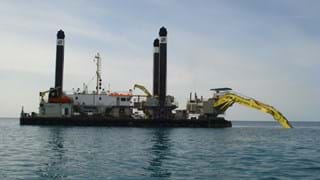The Mumbai High Fields to Uran Trunkline Project is situated near Mumbai (Bombay) in India. ONGC Ltd (Oil & Natural Gas Corporation) has constructed two new pipeline connections from the Mumbai High Fields to Uran over a total length of 204 kilometers. These new pipelines have been constructed in order to replace the existing Bombay High Fields to Uran Trunkline, which had already completed more than 25 years of successful operation and had surpassed its design life. The new pipelines are a 30" oil pipeline and a 28" gas pipeline.
The pipe laying has been executed by Hyundai Heavy Industries Co. Ltd (HHI). Boskalis was awarded a subcontract to execute the pre-trenching, backfilling and landfall works from the Landfall Point to 19.5 kilometers offshore (from Port Limits). Project preparations commenced in August 2004 and all operations were completed in May 2005 well before the start of the monsoon season. Upon completion of the operations within the Port Limits Boskalis was requested to use their expertise for the post-trenching of both pipelines until 130 kilometers offshore.
Pre-Trenching Operations
A trench was dredged to a width of 8 meters in the near-shore section (1.6 kilometers) and to a width of 10 meters further offshore. Soil conditions in the area varied between very soft silty clay and weathered basalt. In the case of hard material, a cover of 1 meter on top of the pipeline was required, in the case of soft material a cover of 3 meters. Three dredging units, each with its own specific features, were mobilized for the operations. The backhoe dredger Colbart dredged the near-shore part of the trench, where the water depth limited the activities of the hopper dredgers, and the sections where hard material was encountered. To pre-handle sections with hard material, the Colbart was fitted out with a S35 hydrohammer. The trailing suction hopper dredgers Flevo and Seaway were mobilized to dredge the shallow parts of the trench and the offshore section respectively. The dredged material was deposited in a temporary storage area at 1 kilometer distance from the trench to be re-used for backfilling.

